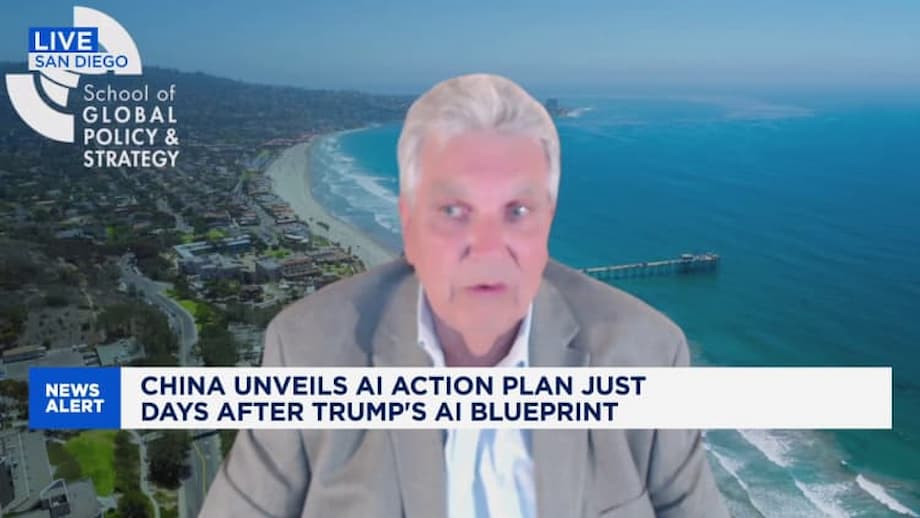Nvidia’s No-Show at China’s Premier AI Event: A Turning Point?
The World Artificial Intelligence Conference (WAIC) 2025 in Shanghai was expected to be a showcase for the latest breakthroughs in artificial intelligence, drawing global tech giants, policymakers, and investors. Yet, the most valuable chipmaker in the world, Nvidia, was conspicuously absent. This absence marked a pivotal moment in the ongoing U.S.-China technology rivalry and signaled a dramatic shift in the global AI landscape.
- Nvidia’s No-Show at China’s Premier AI Event: A Turning Point?
- Why Did Nvidia Skip WAIC 2025?
- Huawei’s Ascend: China’s Answer to Nvidia
- China’s Broader AI Ecosystem: Alliances and Innovation
- Global Tech and Geopolitics: The U.S.-China AI Rivalry
- China’s Generative AI Breakthroughs: More Than Just Hardware
- In Summary
While Nvidia’s absence was not officially explained, it comes amid intensifying U.S. export controls that bar the company from selling its most advanced AI chips to China. The vacuum left by Nvidia was quickly filled by Chinese competitors, most notably Huawei, which used the opportunity to unveil its most ambitious AI hardware yet. The event also highlighted China’s broader push for technological self-sufficiency and global leadership in AI standards.
Why Did Nvidia Skip WAIC 2025?
Nvidia’s decision not to participate in WAIC 2025 surprised many, especially given the company’s recent efforts to tailor its H20 chip for the Chinese market. The H20 is a less advanced version of Nvidia’s flagship AI chips, designed specifically to comply with U.S. export restrictions. However, the company has not disclosed when shipments of the H20 will resume, nor has it provided details on order volumes. This uncertainty, combined with the ongoing ban on its top-tier chips like the H100 and Blackwell series, has left Nvidia’s future in China in question.
According to industry analysts, Nvidia’s absence may have been a strategic move to avoid drawing attention to its constrained position in China. The U.S. government’s restrictions have not only limited Nvidia’s sales but also created an opening for domestic Chinese firms to capture market share. As one analyst put it,
Nvidia’s retreat is accelerating China’s push for AI self-sufficiency and giving rivals like Huawei a chance to shine.
Despite Nvidia CEO Jensen Huang’s recent visit to Beijing, the company did not set up a booth or participate in any official capacity at the conference. This left the field wide open for Chinese competitors to dominate the narrative.
Huawei’s Ascend: China’s Answer to Nvidia
Huawei seized the spotlight at WAIC 2025 by unveiling its CloudMatrix 384 supercomputing system, built around 384 of its latest Ascend 910C AI processors. The system is designed to rival Nvidia’s most advanced offerings, such as the GB200 NVL72, which are now banned from the Chinese market due to U.S. export controls.
Huawei’s CloudMatrix 384 boasts impressive technical specifications:
- 384 Ascend 910C processors across 16 racks
- Peer-to-peer optical interconnect backbone for high-speed, low-latency data transfers
- Over 5.5 petabits per second of internal bandwidth
- 49.2 terabytes of high-bandwidth memory (three times more than Nvidia’s comparable platform)
- Memory bandwidth exceeding 1,200 terabytes per second (double Nvidia’s)
- Estimated compute performance of 300 petaflops, surpassing Nvidia’s GB200 NVL72’s 180 petaflops
- Power consumption of 559 kilowatts—about four times that of Nvidia’s system
While a single Ascend chip is less powerful than Nvidia’s Blackwell or H100 GPUs, Huawei compensates by clustering more chips together and leveraging system-level innovations. This approach allows Huawei to achieve comparable or even superior aggregate performance, albeit with higher energy requirements.
Huawei’s rapid progress is not just a technical achievement—it’s a strategic response to U.S. sanctions. By building a domestic alternative to Nvidia’s GPUs, Huawei is helping China reduce its reliance on foreign technology and strengthen its position in the global AI race.
Challenges and Opportunities for Huawei
Despite its technical advances, Huawei faces significant challenges. U.S. export laws not only restrict Nvidia’s sales to China but also limit Huawei’s ability to compete internationally. The U.S. Commerce Department has warned that companies using Huawei’s Ascend chips globally could face penalties, as the hardware was designed using U.S.-origin technology. This effectively confines Huawei’s AI hardware to the Chinese market.
Nevertheless, analysts expect Huawei’s share of China’s AI chip market to grow from 23% to 28% in 2025. With China’s total AI chip spending projected to reach up to $39.5 billion this year, and broader AI infrastructure investments approaching $91 billion, the stakes are enormous. Major Chinese tech firms like Alibaba and ByteDance are investing heavily in AI computing, further fueling domestic innovation.
China’s Broader AI Ecosystem: Alliances and Innovation
WAIC 2025 was not just about hardware. The conference showcased a vibrant ecosystem of Chinese AI firms forming alliances and launching new products to build a self-sufficient technology stack. Two major industry alliances were announced:
- Model-Chip Ecosystem Innovation Alliance: Connects developers of large language models (LLMs) with AI chip manufacturers, including Huawei, Biren, Moore Threads, and Enflame. This alliance aims to integrate the entire technology chain from chips to models to infrastructure.
- Shanghai General Chamber of Commerce AI Committee: Focuses on promoting the integration of AI technology with industrial transformation. Participants include SenseTime, StepFun, MiniMax, Metax, and Iluvatar CoreX.
These alliances are a direct response to U.S. sanctions, which have blocked Chinese firms from purchasing advanced technology made with U.S. know-how. By fostering collaboration and innovation within China, these groups aim to reduce dependence on foreign suppliers and accelerate the development of homegrown solutions.
Product Highlights from the Conference
Beyond Huawei’s CloudMatrix 384, several other Chinese companies unveiled cutting-edge products:
- Metax: Demonstrated an AI supernode featuring 128 C550 chips for large-scale, liquid-cooled data centers.
- Tencent: Unveiled its open-source Hunyuan3D World Model 1.0, enabling users to generate interactive 3D environments from text or image prompts.
- Baidu: Announced next-generation digital human technology for creating virtual livestreamers, capable of cloning a human’s voice, tone, and body language from just 10 minutes of sample footage.
- Alibaba: Introduced Quark AI Glasses, powered by its Qwen AI model, allowing users to navigate maps and use Alipay via voice commands and QR code scanning.
- NetEase’s Youdao: Presented an AI-powered handheld device for student learning, highlighting advances in power efficiency and edge computing.
These innovations underscore the breadth and depth of China’s AI ecosystem, which is rapidly evolving to meet domestic needs and, where possible, compete globally.
Global Tech and Geopolitics: The U.S.-China AI Rivalry
WAIC 2025 took place against the backdrop of escalating U.S.-China tech tensions. Just days before the conference, U.S. President Donald Trump announced a new AI Action Plan aimed at promoting American technology overseas and reducing bias in AI models. In response, Chinese Premier Li Qiang called for the establishment of an international institution to guide AI collaboration and governance, to be headquartered in Shanghai.
In his keynote address, Premier Li emphasized the need for global standards and risk management in AI development:
AI is a powerful driver of economic expansion, but regulatory approaches vary widely. Nations must harmonize their policies to ensure that rapid advancements do not outpace safeguards.
Li also warned against the monopolization of AI development by a few players and highlighted the challenges posed by export controls and restrictions on expert mobility. China’s push for open-source AI projects and international cooperation is part of a broader strategy to shape the rules and standards of the emerging AI era.
Repairing and Refurbishing Nvidia Chips in China
Despite the export bans, demand for Nvidia’s advanced GPUs remains high in China. A burgeoning industry of repair workshops in cities like Shenzhen has emerged to service Nvidia AI processors that have entered the country through unofficial channels. These workshops refurbish banned H100 and A100 GPUs, servicing up to 500 units monthly. While this supports local demand, Nvidia has warned that only authorized partners can provide proper service and support, and using restricted products without approved support is not viable.
China’s Generative AI Breakthroughs: More Than Just Hardware
Some Western observers have underestimated China’s AI progress by focusing solely on access to Nvidia GPUs. In reality, China’s advances in generative AI are the result of a decade-long national strategy, public-private alignment, and deep investment in talent and infrastructure. Open-source models like DeepSeek’s R1 and V3, Alibaba’s Qwen3, and MiniMax M1 have matched or surpassed Western counterparts in some benchmarks, even under U.S. export constraints.
China’s approach combines architectural innovation, efficiency, and rapid diffusion of AI technologies across industries. The country’s regulatory infrastructure, such as the generative AI algorithm registration database, provides oversight without stifling innovation. Strategic alignment among government, academia, and industry accelerates research and deployment, enabling China to translate breakthroughs into large-scale societal tools quickly.
The Road Ahead: Self-Sufficiency and Global Influence
China’s whole-of-society approach to AI—spanning education, infrastructure, talent development, and regulatory climate—has allowed it to close the gap with the U.S. at remarkable speed. The rise of domestic champions like Huawei, the formation of industry alliances, and the government’s push for global AI governance all point to a future where China is not just a consumer of AI technology but a global standard-setter.
For Nvidia, the challenge is to adapt to a world where its dominance is no longer guaranteed, at least in China. The company remains the global leader in AI data center systems, but geopolitical headwinds and rising Chinese innovation are reshaping the competitive landscape. As one industry expert noted,
Nvidia’s ability to navigate these challenges will determine its long-term value and influence in the global AI ecosystem.
In Summary
- Nvidia was absent from WAIC 2025 in Shanghai, reflecting the impact of U.S. export controls and opening the door for Chinese competitors.
- Huawei unveiled its CloudMatrix 384 supercomputing system, leveraging 384 Ascend 910C chips to rival Nvidia’s top offerings, though with higher power consumption.
- Chinese AI firms formed new alliances to build a domestic ecosystem and reduce reliance on foreign technology.
- The conference highlighted China’s rapid progress in generative AI, driven by national strategy, open-source collaboration, and regulatory innovation.
- Premier Li Qiang called for global AI governance standards, signaling China’s ambition to shape the rules of the AI era.
- Despite export bans, demand for Nvidia chips in China remains high, fueling a gray market for repairs and refurbishment.
- The U.S.-China tech rivalry is intensifying, with both sides unveiling new strategies to secure AI leadership and influence global standards.




